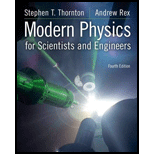
Concept explainers
(a)
The power of the emission in the visible region of the spectrum and compare it with ultraviolet and infrared region.
(a)
Answer to Problem 24P
The fraction of the visible power to the ultraviolet and infrared power is
Explanation of Solution
Write the expression for the ratio of intensities from Planck’s law for the different wavelength.
Here,
Conclusion:
Substitute
Substitute
Thus, the fraction of the visible power to the ultraviolet and infrared power is
(b)
The ratio of intensity at
(b)
Explanation of Solution
Write the expression for the Planck’s law of radiation.
Here,
Write the expression for the total power radiated by the lamp.
Here,
Write the expression for the fraction of power in the visible region.
Here,
Conclusion:
Substitute
Substitute
Substitute
Thus, the fraction of the visible power to the maximum intensity power is
Want to see more full solutions like this?
Chapter 3 Solutions
Modern Physics for Scientists and Engineers
- Show that Stefan’s law results from Planck’s radiation law. Hin: To compute the total power of blackbody radiation emitted across the entire spectrum of wavelengths at a given temperature, integrate Planck’s law over the entire spectrum P(T)=0I(,T)d. Use the substitution x=hckT and the tabulated value of the integral 0dx x 3( e x 1)=415arrow_forwardShow that the energy E in eV of a photon is given by E=1.241106 m/A. where A is its wavelength in meters.arrow_forwardWhy go through the expense of building an electron microscope for studying very small objects such as organic molecules? Why not just use extremely short electromagnetic waves, which are much cheaper to generate?arrow_forward
- Suppose that the microwave radiation has a wavelength of 11.6 cm. How many photons are required to heat 265 mL of coffee from 25.0 degrees Celcius to 62.0 degrees Celcius? Assume that the coffee has the same density, 0.997 g/mL, and specific heat capacity, 4.184 J/(g.K), as water over this temperature range.arrow_forwardA photon has a wavelength in a vacuum of 500nm, if its energy is doubled, what is the associated wavelength in a vacuum?arrow_forwardHow much energy does a photon of UV light (frequency = 3.6 x 1016 Hz) have? How fast do the light travel in a vacuum, water (n=1.33), and glass (n=1.50)?arrow_forward
- Assuming that the smallest measurable wavelength in an experiment is 0.730 fm , what is the maximum mass of an object traveling at 465 m⋅ s^−1 for which the de Broglie wavelength is observable? ?=arrow_forwardWhat is the frequency (in Hz) of an ultraviolet photon with wavelength 139 nm? Express your answer in scientific notation.arrow_forwardThe operating temperature of an indirectly heated filament of a vacuum tube is around 1050K. At what wavelength will it radiate maximum? Given b=0.288cm K.arrow_forward
- Assuming that the smallest measurable wavelength in an experiment is 0.990 fm (femtometers), what is the maximum mass of an object traveling at 269 m/s for which the de-Broglie wavelength is observable?arrow_forwardShow that at long wavelengths, Planck’s radiation law reduces to the Rayleigh–Jeans law.arrow_forwardA housing attached to a microprocessor uses radiator fins to get rid of excess heat. If the largest amount of radiation emitted by the fins has a frequency of 156.05 THz, what is the associated wavelength? marrow_forward
 University Physics Volume 3PhysicsISBN:9781938168185Author:William Moebs, Jeff SannyPublisher:OpenStax
University Physics Volume 3PhysicsISBN:9781938168185Author:William Moebs, Jeff SannyPublisher:OpenStax Modern PhysicsPhysicsISBN:9781111794378Author:Raymond A. Serway, Clement J. Moses, Curt A. MoyerPublisher:Cengage Learning
Modern PhysicsPhysicsISBN:9781111794378Author:Raymond A. Serway, Clement J. Moses, Curt A. MoyerPublisher:Cengage Learning Physics for Scientists and Engineers with Modern ...PhysicsISBN:9781337553292Author:Raymond A. Serway, John W. JewettPublisher:Cengage Learning
Physics for Scientists and Engineers with Modern ...PhysicsISBN:9781337553292Author:Raymond A. Serway, John W. JewettPublisher:Cengage Learning


